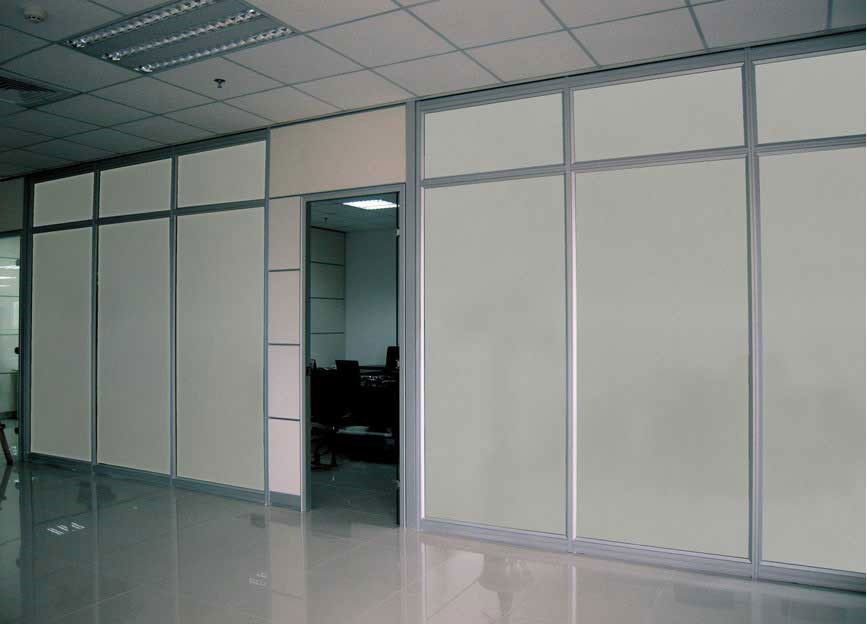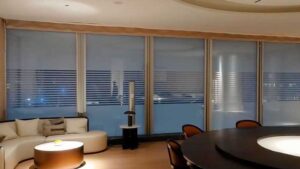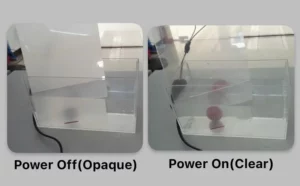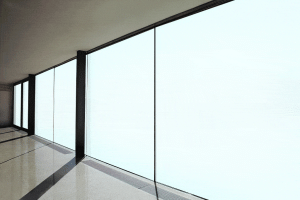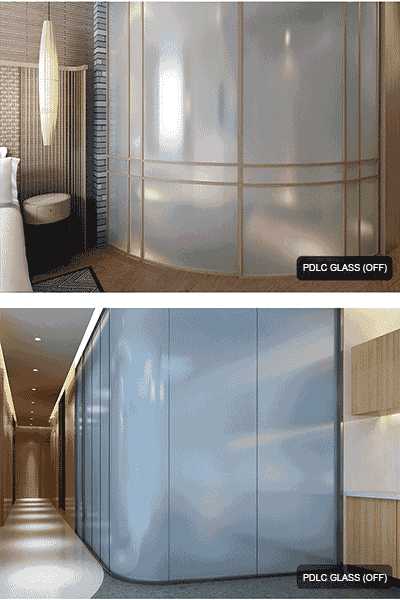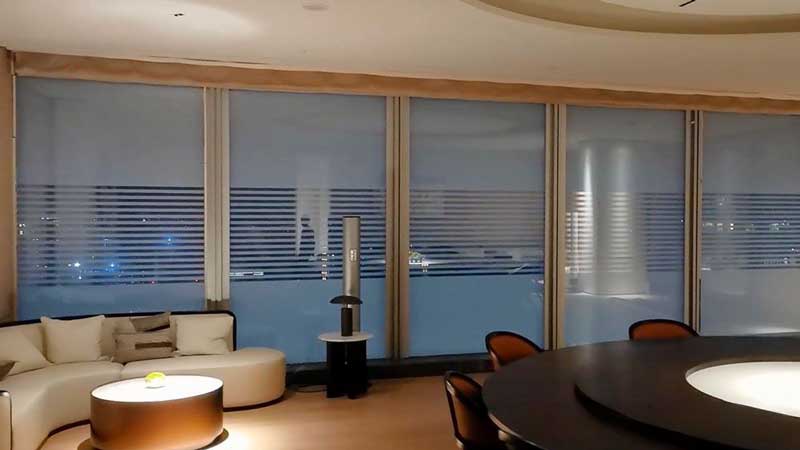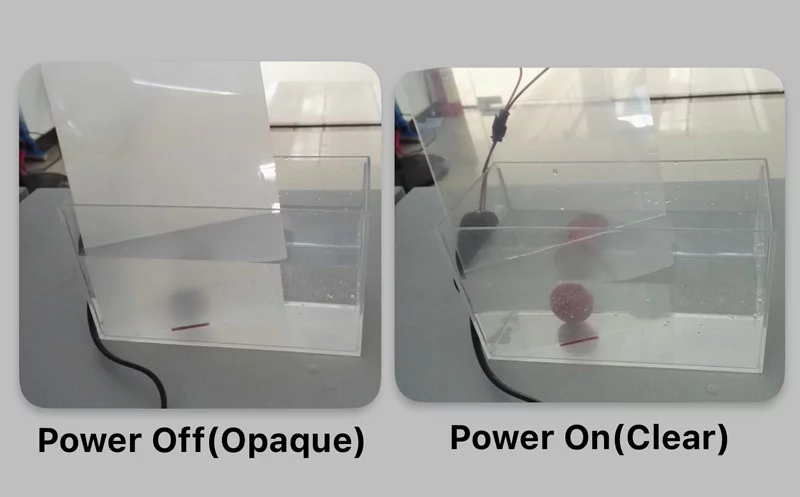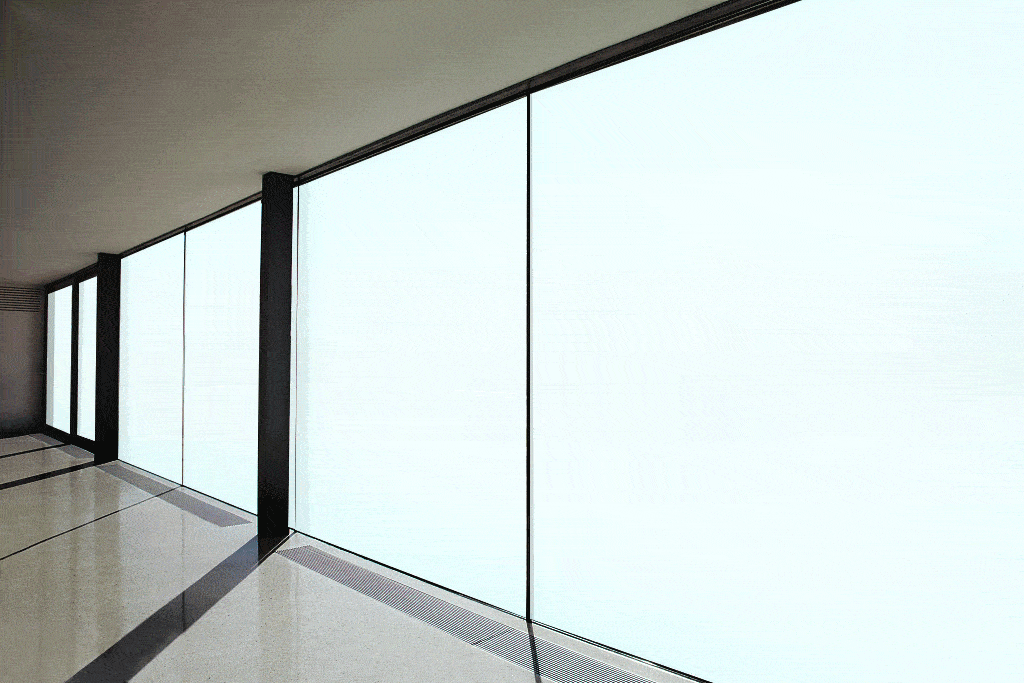Switchable PDLC glass is an innovative glass technology that allows you to control the level of transparency. PDLC stands for Polymer Dispersed Liquid Crystal, which are films of liquid crystal droplets dispersed in a polymer that can be switched from transparent to opaque when a voltage is applied. This enables you to change the glass from clear to translucent or frosted at the flip of a switch.
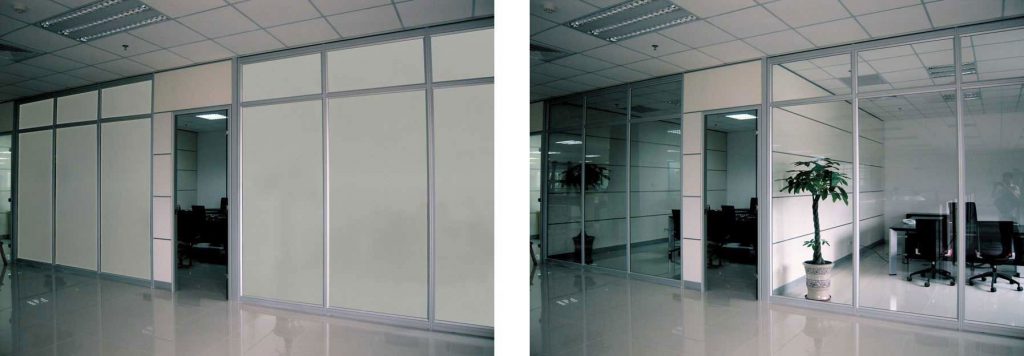
Switchable PDLC Glass also call Smart Privacy Glass, electric privacy glass for window, electronic privacy glass, Functional Glass, Privacy glass, privacy glass for partition, glass for window and door, Smart glass electric switchable glass for Door, Smart Glass Office partitions, Switchable Electrochromic Glass.
How Does Switchable PDLC Glass Work?
The core of PDLC glass is a layer of liquid crystal film sealed between two sheets of glass or plastic. When no power is supplied, the liquid crystals scatter light in random directions, causing the glass to appear frosted or cloudy. But when voltage is applied, the liquid crystals align in a uniform direction, allowing most light to pass directly through so the glass becomes transparent.
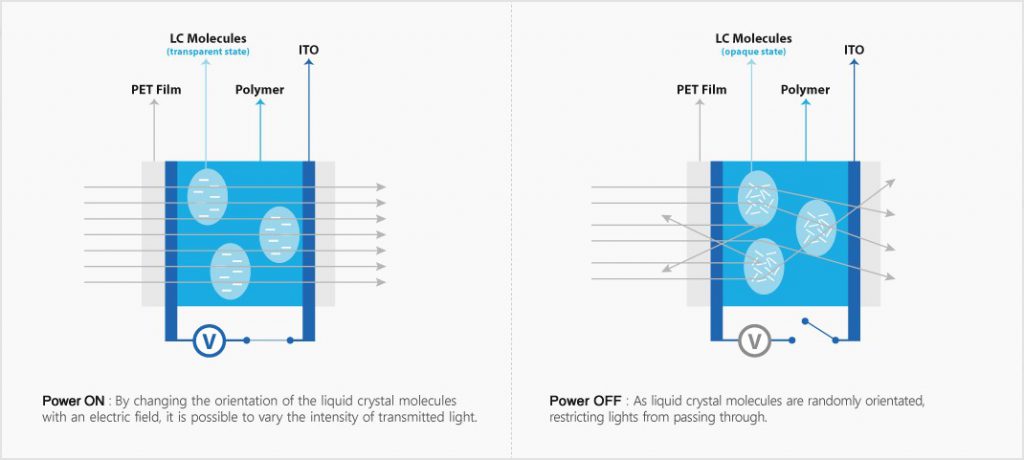
The amount of transparency is determined by the strength of the voltage applied. Low voltage results in minimal light transmission for maximum privacy, while higher voltage produces nearly see-through clarity. This enables step-less control of transparency, from opaque to clear. When the power is cut, the glass immediately returns to its frosted state.
Types of PDLC Glass Products
PDLC glass comes in sheet, film, or panel forms for various applications, here are some types of smart PDLC products:
- Self-Adhesive PDLC Film: This type of PDLC film comes with a self-adhesive backing, allowing it to be easily applied to existing glass surfaces. It provides a cost-effective solution for transforming standard glass into switchable PDLC glass.
- Laminated PDLC Smart Glass: These are the standard switchable PDLC glass panels that can transition between transparent and opaque states. They can be used to create switchable privacy partitions in offices, hotels, or other spaces. These partitions provide the flexibility to switch between transparent and opaque states, enabling privacy or an open layout as needed.
- Pattern PDLC Glass: Pattern PDLC glass is designed with specific patterns or designs embedded within the glass. When the PDLC film is switched to the transparent or opaque state, the patterns become visible, offering a unique aesthetic appeal.
- Smart Blinds PDLC Glass: Smart Blinds PDLC Glass is made by sandwiching the Smart Blinds PDLC film between two glass panels. The Smart Blinds PDLC film uses the same technology as the regular PDLC film, but with a difference. The regular PDLC film is a complete piece of film connected to electricity directly, while the Smart Blinds PDLC film is laser cut the ITO coating into different sections, with each section being connected to electricity separately. This enables individual control of each section’s power on/off, which allows the film to have a smart blinds effect when used with a special controller.
- PDLC Low-E (Low Emissivity) Smart Glass: This type of PDLC glass incorporates a low-emissivity coating that helps to minimize heat transfer and improve energy efficiency. It provides both switchable functionality and thermal insulation properties.
- PDLC One-Way Mirror Glass: PDLC glass can be designed as a one-way mirror, allowing visibility from one side while appearing as a mirror from the other side. This type of glass is often used for privacy and surveillance applications.
- PDLC Double-Glazed Glass: Double-glazed PDLC glass consists of two or three glass panels with a PDLC film sandwiched between them. This design provides enhanced insulation, noise reduction, and energy efficiency.
- PDLC Triple-Insulated Glass: Similar to double-glazed glass, PDLC triple-insulated glass includes three or four glass panels with PDLC film interlayers. It offers even higher levels of insulation, soundproofing, and energy efficiency compared to double-glazed glass.
- PDLC Switchable Projection Glass: This type of PDLC glass serves as a projection surface when in the opaque state, allowing high-quality projection of images and videos. It can be used in various multimedia and display applications.
- PDLC Interactive Glass: PDLC interactive glass incorporates touch-sensitive technology, enabling it to function as an interactive display or touchscreen surface. It provides an engaging and interactive experience for various applications such as retail, museums, and exhibitions.
These are just a few examples of smart PDLC glass types. The versatility of PDLC technology allows for customization and adaptation to various requirements in terms of functionality, energy efficiency, and design. From self-adhesive films for retrofitting to PDLC Interactive Glass, PDLC technology continues to expand its versatility and application possibilities.
What is Switchable PDLC Glass Used For?
PDLC smart glass can be used in a variety of applications, including:
Privacy Solutions:
Smart PDLC glass offers an ideal solution for privacy control in various settings, including offices, conference rooms, hospitals, and residential spaces. With a switchable transparency feature, it allows users to instantly switch between transparent and opaque states, ensuring privacy when needed.
Interior Design:
Smart PDLC glass provides opportunities for innovative and dynamic interior design. It can be used as partitions, room dividers, or even as decorative elements in homes, hotels, restaurants, and retail spaces. The ability to switch between transparent and opaque states adds versatility and enhances the aesthetic appeal of any space.
Projection Screens:
PDLC glass can serve as a high-quality projection surface, making it an excellent choice for home theaters, conference rooms, and multimedia installations. It offers a clear display when in the transparent state and transforms into a projection screen when switched to the opaque state.
Retail Displays:
Switchable PDLC glass creates an interactive and engaging shopping experience. It can be used for product showcases, digital signage, and interactive displays in retail stores, showrooms, and exhibitions.
Skylights and Roofing:
PDLC glass can be integrated into skylights and roofing systems to control sunlight and heat. By adjusting the transparency, it helps regulate the amount of natural light and heat entering a space, offering energy efficiency and creating a comfortable environment.
Security and Surveillance:
PDLC glass can be utilized in security applications, such as one-way mirror glass for surveillance rooms, police stations, or high-security facilities. It allows for discreet observation and maintains privacy from the outside.
Healthcare Environments:
In hospitals, clinics, and medical facilities, PDLC glass can be used in patient rooms, operating theaters, and consultation areas. It provides privacy for patients and allows medical professionals to create suitable working environments.
Smart Homes:
PDLC glass adds a touch of modernity to smart home setups. It can be used for smart windows, smart partitions, or even as a switchable backsplash in kitchens.
Hospitality Industry:
Smart PDLC glass finds great use in the hospitality industry, including hotels, resorts, and restaurants. It can be employed as a privacy solution for hotel room partitions or bathroom enclosures, providing guests with the option to control privacy levels. Additionally, it can be used in restaurants and bars as a partition or as an innovative design element to create dynamic and customizable spaces.
Museums and Galleries:
Smart PDLC glass offers a unique way to showcase artworks and exhibits in museums and galleries. By switching the glass to its transparent state, viewers can fully appreciate the displayed items. When switched to the opaque state, it provides protection and preserves the artwork from excessive light exposure or vandalism.
In conclusion, smart PDLC glass offers a multitude of applications across various industries and environments. Whether it’s providing privacy solutions in offices or healthcare facilities, enhancing interior design in homes and retail spaces, or creating engaging displays in museums and retail stores, smart PDLC glass proves to be a versatile and innovative solution.
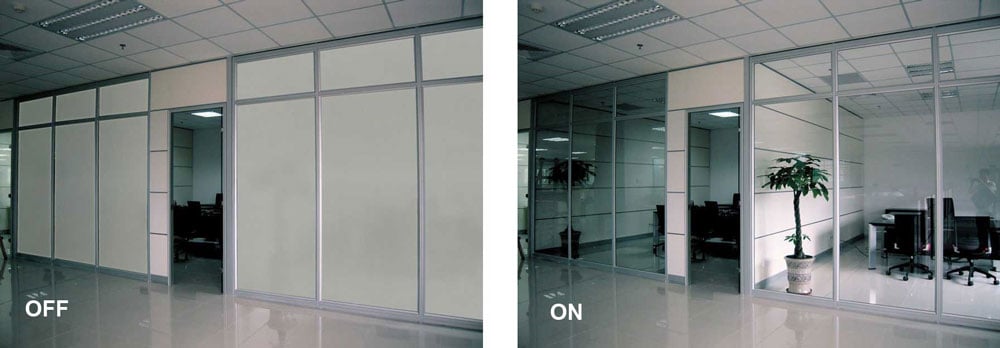
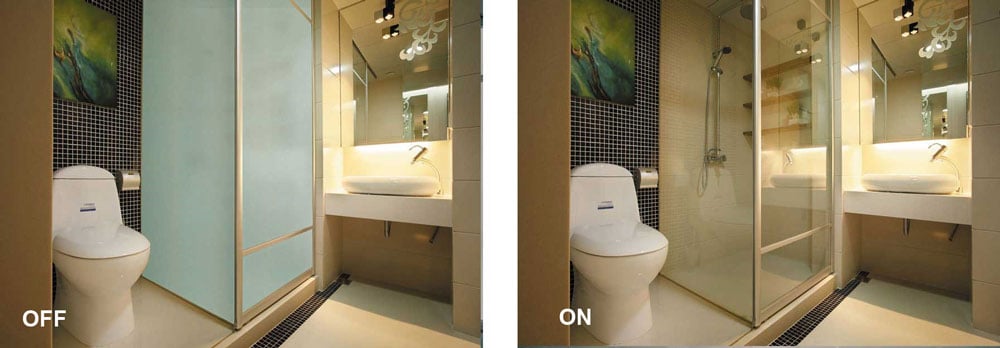
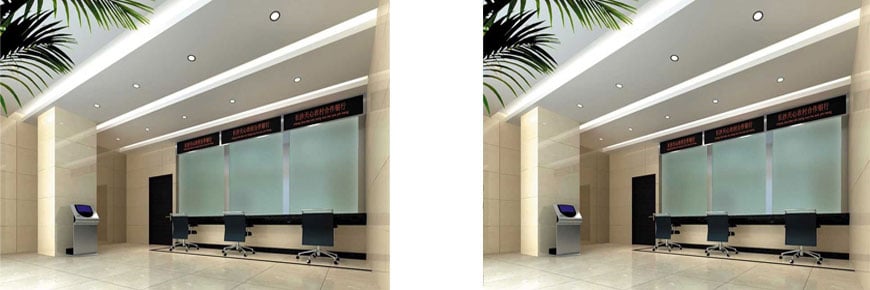

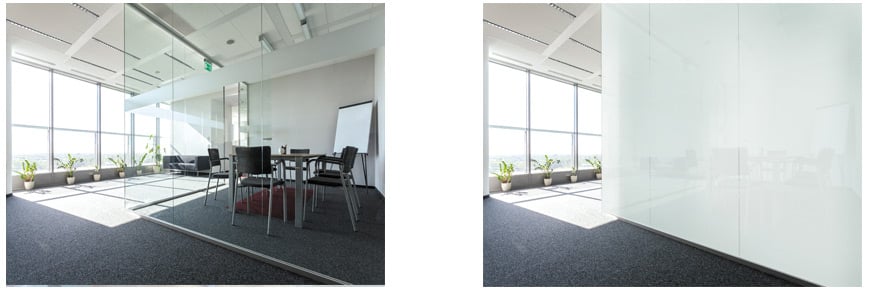
The ability to switch between transparent and opaque states enables users to have control over their spaces, allowing for privacy when needed or creating an open and interactive environment. From projection screens and skylights to security applications and smart homes, smart PDLC glass brings functionality, aesthetic appeal, and energy efficiency to different settings.
In the hospitality industry, it offers privacy options for hotel rooms and creates dynamic spaces in restaurants and bars. Museums and galleries benefit from the ability to showcase artworks while ensuring their protection.
Overall, smart PDLC glass continues to revolutionize the way we think about glass and its applications. Its versatility, combined with its practical and aesthetic benefits, makes it an ideal choice for architects, interior designers, business owners, and homeowners looking to incorporate innovative and customizable solutions into their spaces.
Key Technical Specifications of Switchable PDLC Glass
The performance of PDLC (Polymer Dispersed Liquid Crystal) glass is influenced by several key factors. These factors determine its functionality, quality, and overall effectiveness. Here are the key factors that play a crucial role in PDLC glass performance:
| Transparency: | PDLC glass should provide a high level of transparency when in the clear or transparent state. It should allow for maximum visibility and clarity, ensuring that the glass serves its purpose effectively. |
| Opaqueness: | When switched to the opaque state, PDLC glass should offer complete privacy and block the transmission of light. The opaqueness should be uniform across the glass surface, preventing any visibility through the glass. |
| Switching Speed: | The speed at which PDLC glass transitions between the transparent and opaque states is an important factor. Fast switching speed ensures quick response times and convenient usability. |
| Switching Control: | PDLC glass should provide reliable and easy-to-use switching control mechanisms. This can include manual switches, remote control, or integration with smart home automation systems. |
| Power Consumption: | The energy efficiency of PDLC glass is crucial. It should consume minimal power during the switching process to ensure sustainability and cost-effectiveness. |
| Durability: | PDLC glass should be durable and able to withstand frequent switching without compromising its performance or longevity. It should be resistant to physical damage, moisture, and other environmental factors. |
| Optical Quality: | PDLC glass should maintain optical clarity and consistency over time. It should be free from defects such as blemishes, distortions, or irregularities that can affect visibility. |
| UV Protection: | PDLC glass can provide UV protection by blocking harmful UV rays when in the opaque state. This feature is particularly important in applications where UV radiation needs to be minimized, such as in museums or for protecting interior furnishings. |
| Soundproofing: | PDLC glass can offer sound insulation properties, reducing noise transmission when in the opaque state. This is beneficial in applications where sound control and privacy are important, such as conference rooms or healthcare facilities. |
| Viewing Angle: | PDLC glass performance can be influenced by the viewing angle at which it is observed. Ideally, PDLC glass should provide consistent transparency and opaqueness across a wide range of viewing angles. Maintaining a high-quality visual experience regardless of the observer’s position enhances usability and ensures a satisfying user experience. |
| Dimension: | The dimensions of PDLC glass panels play a crucial role in their performance. Larger panels may require additional structural support and precise manufacturing processes to maintain their integrity and functionality. It’s important to consider the size limitations and installation requirements when selecting PDLC glass to ensure optimal performance and long-term durability. |
Considering these key factors will help in selecting high-quality PDLC glass that meets specific requirements and delivers reliable performance for various applications.
How Much Does Switchable PDLC Glass Cost?
The cost of smart PDLC glass can vary depending on several factors, including the size, complexity of the project, customization requirements, and the supplier or manufacturer. It’s important to note that smart PDLC glass is generally more expensive than traditional glass due to its advanced technology and unique properties.
For standard-sized switchable PDLC glass panels, the cost can range from around $110 to $200 per square meter(Manufacturing in China). However, larger or custom-made panels may incur higher costs. Additionally, the cost may increase if additional features like low-E coating, patterned designs, or integrated smart blinds are included.
It’s recommended to contact suppliers or manufacturers directly to obtain accurate pricing information as it can vary significantly based on specific project requirements and market conditions. They can provide detailed quotations and offer insights into any additional costs associated with installation, shipping, or customization.
It’s important to consider the long-term benefits and value that smart PDLC glass brings, such as energy efficiency, privacy control, and enhanced aesthetics, when evaluating its cost.
How to Choose the Right Type of PDLC Glass
The type of PDLC glass required depends entirely on how and where you plan to use it. Factors to consider include:
•Privacy Level: Choose between opaque, translucent, or highly transparent. Pick a type providing your desired level of privacy when powered off.
•Light Control: If controlling natural light is the priority, choose between glass offering over 90% transmittance when on down to less than 10% for maximum light blockage when off.
•Display: For an interactive display, pick glass optimized for high clarity, few visual distortions and wide viewing angles when on along with privacy when off.
•Location/Safety Rating: For partitions/doors, pick glass certified as safety glass. For skylights, choose glass specifically rated for such applications to ensure building code compliance, and impact/weather resistance.
•Dimensions: Comes in stock sizes and custom-cut panels up to 100 square feet or more depending on type. Make sure your intended installation space can accommodate the glass size needed.
•Durability: For long-term continuous use, high durability, UV-protected glass is best. For temporary or occasional use, standard glass works sufficiently.
•Extra Features: Options include UV protection, faster switching speed, anti-glare, impact resistance, broader viewing angles, colored or tinted frosted appearance. Added features increase functionality and cost.
For the most suitable PDLC glass products, consult a reputable supplier. They can recommend types based on your application, provide samples to view personally, and determine the necessary control systems and installation components to suit your needs. With an experienced supplier, you’ll source the best PDLC glass solutions.
How to Choose a Controller for PDLC Glass
Controllers supply and control the power to PDLC glass panels. Several factors determine the best controller for an application:
- Power output: 50 to 500W or higher based on the total square meter of glass. More panels require higher output.
- Control features: Basic on/off switch, remote controller, variable control of transparency level, programmable timers or automation compatibility. Advanced controllers enable finer control and customization.
- Location: Wall-mounted, built-in or weather-resistant. Choose a controller suited for indoor or outdoor installation.
- Number of channels: Controls each panel individually or in groups. More channels provide independent control for each panel.
For most uses, a 100W to 400W multi-channel programmable controller works well for adjusting a few average-sized PDLC panels. Larger, more complex installations may require a customized control system to properly synchronize 20 or more panels. The right controller ensures you get the performance and functionality you want from your PDLC glass.
Buyers Guide for Switchable PDLC Glass
When it comes to purchasing PDLC glass, we understand that you have the autonomy to make decisions that best suit your needs. While we are committed to providing excellent support, here are some recommendations to help you in the process:
Consider Your Budget:
One of the crucial factors is determining the total budget you are willing to allocate for the PDLC glass purchase. At PDLCGLASS, we pride ourselves on offering the best products within your budget. We encourage you to research the market and compare prices. Additionally, check customer reviews to gain insights from users who have used our products.
Follow these 9 Steps to Purchase from PDLCGLASS:
Step 1: Consultation – Share your requirements and dimensions, including the application environment and material dimensions (Length * Width). We will recommend the most suitable PDLC glass products.
Step 2: Quotation – We will provide a detailed quotation, including the types of PDLC glass, controllers, accessories, tools, and competitive pricing.
Step 3: Process Evaluation – Both parties carefully evaluate the technical parameters, specifications, and business terms of the order to ensure clarity and avoid misunderstandings.
Step 4: Placing Order – If you are satisfied, we will send you a Proforma Invoice (PI), and a contract will be signed if necessary.
Step 5: Production – Upon receiving your contract and deposit, we will initiate PDLC glass production. You will be regularly updated on the latest production progress.
Step 6: Inspection – Our production process undergoes regular inspection and strict quality control. All PDLC glass sets are thoroughly tested before leaving the factory.
Step 7: Delivery – We will arrange delivery according to the terms agreed upon in the contract.
Step 8: Customs Clearance – We will provide all necessary shipping documents to ensure a smooth customs clearance process.
Step 9: Support and Service – We offer professional technical support and 24/7 customer service via Phone, Email, WhatsApp, Online Live Chat, and Remote Service.
Rest assured that at PDLCGLASS, we are committed to providing the highest quality products and support. Feel free to reach out to us whenever you need assistance.
Why Should You Choose from PDLCGLASS?
We(PdlcGlass) are a professional solution provider and manufacturer of Switchable PDLC Glass and PDLC smart film. Our team set foot in the field of Pdlc (Polymer-Dispersed Liquid Crystal) glass as early as the year 2009.
• Professionalism: PDLCGLASS has over 15 years of experience in the field of intelligent glass, smart PDLC glass, and laminated glass manufacturing.
• One-stop Solution Service: Tell us your needs, and we will carry out the full solution, and offer you a suitable product. We provide a streamlined process, offering expert guidance, customization, timely delivery, professional installation guide, and ongoing support. Enjoy a seamless experience, from product selection to project completion, all from a single trusted partner.
• High Quality: Our products are built to last, with a lifespan of up to 15 years and resistant to impact and scratches.
• Global Reach: PDLCGLASS has exported to over 40 countries, including America, the Middle East, Europe, Australia, and many other regions and countries.
How to Use Switchable PDLC Glass?
Using switchable PDLC (Polymer Dispersed Liquid Crystal) glass is relatively straightforward. Here are the general steps to use switchable PDLC glass:
| Power Connection: | Ensure that the switchable PDLC glass is properly connected to a power source. The glass requires an electrical current to switch between the transparent and opaque states. |
| Switching Control: | Use the designated switching control method to activate the PDLC glass. This can be a manual switch, remote control, wall-mounted keypad, or integration with a smart home automation system. Follow the instructions provided with the specific switching control device. |
| Default State: | When the PDLC glass is not connected to electricity, it remains in the opaque state by default. In this state, the glass is frosted or opaque, obscuring the view and providing privacy. |
| Power On: | Activate the power source or switch to supply electricity to the PDLC glass. As the electrical current is applied, the glass will start transitioning to the transparent state. |
| Transparent State: | As electricity flows through the PDLC glass, it turns transparent within a second. In the transparent state, the glass becomes clear, allowing light to pass through and providing visibility. |
| Control Multiple Panels (if applicable): | If you have multiple switchable PDLC glass panels or zones that need to be controlled independently, ensure that you understand the control setup. Some systems allow individual control of each panel or zone, while others may have synchronized control for multiple panels. |
| Power Off: | When you no longer need the PDLC glass to be in the opaque state, switch off the power or use the switching control to revert it to the transparent state. This restores the glass to its clear and transparent state. |
It’s important to follow the manufacturer’s instructions and guidelines specific to the switchable PDLC glass product you have to ensure proper usage and maximize its lifespan. If you have any uncertainties or specific questions, consult the manufacturer or supplier for detailed instructions and support.
Using and Caring For Switchable PDLC Glass
To maximize the performance and lifespan of PDLC glass, follow these tips:
- Clean panels regularly using mild glass cleaner and water. Gently wipe with a soft cloth to avoid scratches. Never use abrasive cleaners or pads. Wait until the glass is completely dry before powering on。
- Protect panels from impacts, scratches or scraping. Damage can impact performance.
- Shelter control units from extreme heat/cold and weather exposure which can temporarily disrupt function.
- Inspect connections/wiring regularly. Repair or replace damaged parts immediately.
- Test panels periodically to ensure proper transparency levels and switching between on/off states. Replace malfunctioning panels/components.
- For outdoor installation, have a professional apply protective sealant to weatherproof panels/components. Reapply every few years.
With proper care and maintenance, PDLC glass should provide many years of reliable performance. But components eventually require replacement. Work with your supplier for repair, servicing or replacement parts to maximize the working lifespan of your PDLC glass.
Troubleshooting Common PDLC Glass Issues
If panels malfunction, check the following:
- Power supply – Ensure the control unit has power and is supplying voltage to panels. Flip breaker switch to reset or replace fuse if tripped.
- Wiring/Connections – Check for any damage or loose connections. Tighten/replace as needed. Faulty wiring requires replacement.
- Settings – Settings may have been accidentally changed. Reset controller to factory defaults and reprogram to your required specs.
- Environment – Extreme temperatures can temporarily impact performance. Wait for glass to reach room temperature and retest function.
- Panel damage – Severely damaged panels likely won’t function properly even when powered on. Repair or replace damaged panels.
- Component failure – If issues persist after checking other items, internal parts likely need replacement by a technician.
In summary, switchable PDLC glass provides an innovative way to precisely control light, privacy and display effects with the touch of a button. With the right glass and control system for your needs, proper installation and care, switchable PDLC glass offers many future years of customized performance. Make your space fully smart and interactive with switchable PDLC glass!
If you have any questions or require further clarification, please don’t hesitate to Contact Us!

